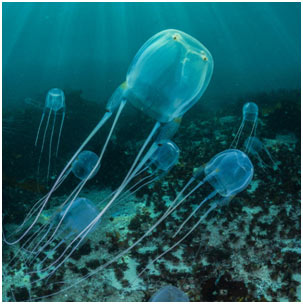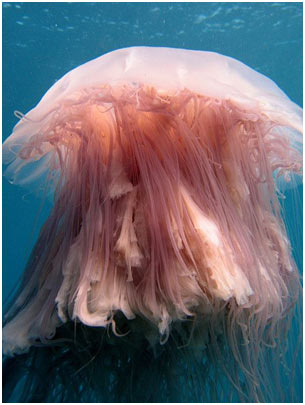About Jellyfish!!!
Jellyfish a member of phylum cnidaria present in almost all types of ocean waters. Jellyfish has radial symmetry and the body consists of three main parts. On the top, there is umbrella, oral arms and tentacles with stings. These have special stinging cells called nematocysts – characteristic of phylum cnidaria.
These tentacles provide them defense and also help in capturing food. Being carnivorous in nature, they feed on small ocean organisms like planktons, small fish or fish eggs. Some of the jellyfish contain venom. These organisms are also responsible for some of the major power plants shut down like Diablo Canyon Power Plant in 2008.
The Dangerous Jellyfish
There are practically 200 known species of jellyfish across our planet’s seas. While a lot of them are in fact quite safe, there are numerous species that have extremely poisonous stinging cells that can cause serious consequences for humans– such as extreme pain and even death. Most species have actually tentacles packed with stinging cells called nematocysts.
When these stinger cells are activated the internal pressure builds up to an enormous 2,000 psi (136 atmospheres) whereupon it bursts, shooting out a toxic substance harpoon. This is one of the fastest motions in nature and quicker than a bullet. The majority of jellies aren’t all that harmful– however, others are lethal. What is the world’s most dangerous jellyfish? Let’s have a look at a few of the contestants.
1.Box Jellyfish (Chironex fleckeri)
It appears to go without saying that the meanest, most poisonous, and deadliest of all jellyfish lives in Australia. The variety of box jellyfish called the sea wasp or marine stinger is commonly considered one of the most deadly animals on earth. In addition to other box jellies, they have been accountable for a minimum of 5,568 deaths recorded since 1954. The Australian range causes around 1 death a year typically with an additional 100 in South East Asia.

The 15 tentacles can rise to 3 meters (10 ft) long and each is covered in around half a million venom-infused, microscopic darts. It is estimated that each animal includes enough venom to kill 60 adult humans. The venom acts very quickly and it can eliminate within minutes causing cardiovascular collapse. It likewise assaults the nervous system and skin cells.
2.Chiropsalmus Quadrigatus
This species of box jellyfish is a smaller version of the Chironex fleckeri. Despite its small size, this jellyfish packs quite a wallop. They can generally be found in the waters of the Indo-Pacific and the Western Atlantic Oceans, and are known as “habu” in Japan’s Okinawa Prefecture, where encounters between people and this species happen annually.

The sting of the Chiropsalmus Quadrigatus is very agonizing and can be fatal in specific cases. Its sting can trigger cardiac arrest, breathing failure with severe pulmonary edema, or death.
3.Irukandji Jellyfish
What the Irukandji jellyfish lacks in size it offsets in the power of its venom. The only reason this animal isn’t at the top of our list of the majority of harmful jellyfish is its little size. Regardless of this the sting lacks doubt potentially deadly.

Typically, one sting will not kill as long as appropriate treatment is given. In nonfatal stings, Irukandji syndrome might develop with delightful signs such as unbearable muscle cramps, extreme pain in the back and kidneys, burning sensation of the skin and face, vomiting, headache, and increased heart rate.
4.Portuguese Male o’ War
This one really is dangerous– extremely hazardous in fact. Amusingly enough, it is also not a real jellyfish, however rather something called a bluebottle. To contribute to the amazing strangeness of the Man o’ War, it is not even an animal. Technically, it is a nest of organisms.
The bladder in them serves an extra purpose of acting as a float and typically sticks up above the water like a sail. Generally, these nests are purple and pink, though they often have a blue tint instead. They are quite elegant and amazing to behold.

It is likewise one of the deadliest jellyfish on the planet. The sting leaves a welt like a whip mark, which can be extremely painful for a number of days.
5.Lion’s Mane Jellyfish
The lion’s mane jellyfish is the biggest type known to man. With a bell rising to 8 feet (2.5 m) or more throughout and tentacles tracking over 100 ft (30m) these beast jellies can weigh around a quarter lot. They likewise occur in big swarms suggesting a convergence of these on your local beach is going to put it out of bounds. The lion’s mane is a Coldwater species and can be found throughout the North Atlantic, consisting of the UK. It can also be found in cooler Australian waters.

The sting itself can be highly unpleasant as being potentially deadly.
6.Morbakka Fenneri
Morbakka fenneri, referred to as the fire jellyfish for its potent sting, resides in the calm waterways and marinas off the coast of Queensland, choosing the warmer waters of the north. It is another species of box jellyfish and is a bit larger than the other jellyfish on this list, determining roughly four inches in length with a two-inch bell size and a strong body with brilliant pink, wart-like protrusions on the top.

While the stings are undoubtedly uncomfortable and have actually been related to serious Irukandji Syndrome, they are not normally dangerous.
7.Cannonball Jellyfish
This is yet another stinging species that numerous swimmers assume to be lethal. Like moon jellyfish, they are reasonably docile and safe, however, and hardly ever sting human beings.

They get captured in anglers’ nets a lot, and their sting is considered fairly harmless.
8.Moon Jellyfish
This one ought to barely even make this list. Moon jellies are very typical, and chances are if you have actually gone to an aquarium and seen a jellyfish, you saw a moon jelly. They do sting, but the irritation is typically rather mild, and they are not considered unsafe by scientists.

They are included in numerous other lists– but their risk is overemphasized by laymen. If anything makes them problematic to swimmers, it is merely how common they are. They highlight the fact that jellyfish are, on the whole, not as dangerous or frightening as many swimmers believe.
9.Sea Nettle
The Sea Nettle is obviously called for nettle plants. They have long, wispy arms, and are frequently found are the Chesapeake Bay area off the East Coast of the United States.

Flowers of sea nettle are common and hazardous. Sea nettles have 24 arms each which can reach as far as six feet. The stings are harmful enough to cause severe pain, but thankfully they are rarely life-endangering.

